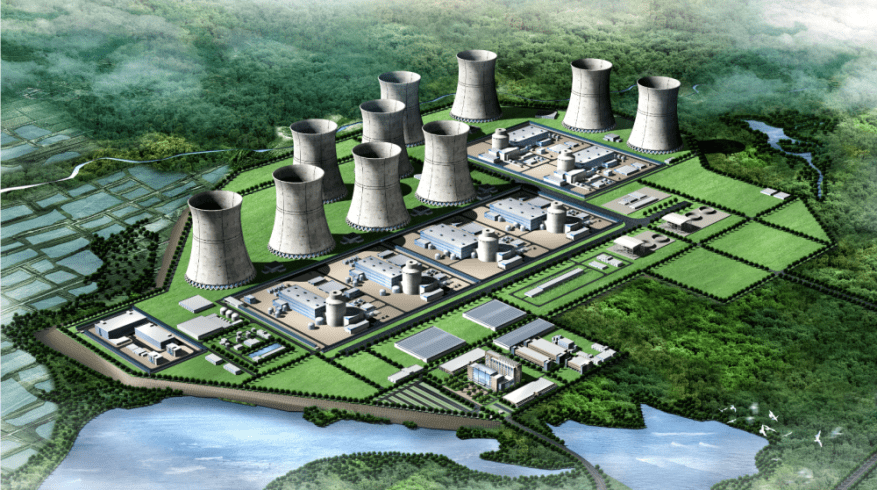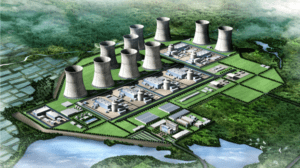China Will Add Two More AP1000 Nuclear Reactors

China's State Council has approved two AP1000 nuclear reactor units for State Power Investment Corp.'s (SPIC's) Lianjiang Nuclear Power Plant in Zhanjiang, Guangdong province, reactor technology supplier Westinghouse said on Oct. 12.
If built, the units will become ninth and tenth reactors based on Westinghouse's Generation III+ advanced reactor technology in China. Four AP1000 units are already currently operating in China: Sanmen 1 and 2 in Zhejiang province and Haiyang 1 and 2 in Shandong province. The four reactors were commissioned in 2018.
 The Lianjiang Nuclear Power Project is located in Tianluoling, Cheban Town, Lianjiang City, Zhanjiang City, Guangdong province, 48 kilometers away from Lianjiang City and 65 kilometers away from Zhanjiang City. This image envisions what the six-unit plant will look like when completed. Courtesy: SPIC
The Lianjiang Nuclear Power Project is located in Tianluoling, Cheban Town, Lianjiang City, Zhanjiang City, Guangdong province, 48 kilometers away from Lianjiang City and 65 kilometers away from Zhanjiang City. This image envisions what the six-unit plant will look like when completed. Courtesy: SPICAnother four CAP1000 reactors-China's licensed adaptation of the AP1000-are under construction at the Sanmen and Haiyang plants. Sanmen 3 and 4. China National Nuclear Corp. (CNNC) kicked off construction of the second phase at Sanmen in June 2022, while Shanghai Nuclear Engineering Research and Design Institute (SNERDI), a SPIC affiliate, poured first concrete for Haiyang's second phase in July 2022. The State Council approved the two projects in April. By Sept. 25, SNERDI, a general contractor for both projects, reported it had separately hoisted in place containment vessels at Haiyang 3 and Sanmen 3.
SNERDI is also building CAP1000s at Lianjiang 1 and 2. The company on Sept. 28 announced it began excavation for the Lianjiang plant's first phase. The site is designed to host a total of six 1.2-GW reactors, said SNERDI.
Speeding Toward Nth-of-a-Kind'Westinghouse in a statement congratulated SPIC on adding the AP1000-derived plants to its growing fleet. It said the AP1000 plant is the only operating Generation III+ advanced reactor with fully passive safety systems, modular design, and has the smallest footprint per MWe on the market." The reactors at Sanmen and Haiyang utilize the most advanced, proven technology and have set industry records with their outstanding startup, availability, and operational performance. One unit at the Haiyang site is generating both electricity and steam for district heating," it noted.
China's AP1000 derivatives stem from technology transfer agreements between China's State Nuclear Power Technology Corp. (SNPTC) and Westinghouse to standardize the reactor technology and enable domestic production of components. In April, as the State Council approved the second phases at Sanmen and Haiyang, Westinghouse said its partnership with SPIC-which was created through the 2015 merger of China Power Investment Corporation and SNTPC-takes full advantage of the AP1000's plant's outstanding performance in the four existing operating units."
A key benefit has been to accelerate serial building of the technology, Westinghouse noted. [T]hrough our successful partnership with [SPIC] in China, we expect to achieve an AP1000 plant nth-of-a-kind' project with the construction cost and schedule of these next four units validating the recent Massachusetts Institute of Technology (MIT) report conclusions regarding the attractive cost and schedule for future AP1000 units."
On Wednesday, Westinghouse President and CEO Patrick Fragman said the company is proud to be a part of this 15-year nuclear energy cooperation program and delivering on our commitment to enable a fleet of AP1000 units to power a carbon-zero future for China."
Future Prospects in China, Europe, and Maybe Even the U.S.Along with China's AP1000 builds, two AP1000 units are currently being completed at the Vogtle site in the U.S. in n Waynesboro, Georgia. Southern Co., which owns 45.7% of that project through its subsidiary Georgia Power, says significant progress continues to be made at the Vogtle 3 & 4 nuclear expansion site. Direct construction at Unit 3 is approximately 99% complete, and the total project is approximately 96% complete. Georgia Power currently projects a Unit 3 in-service date in either the fourth quarter of 2022 or first quarter 2023. Unit 4 is projected to be complete in either the third or fourth quarter of 2023. Vogtle 3, in August, notably, received the Nuclear Regulatory Commission's green light to load fuel and begin the operation of the unit. Vogtle 3 is the first reactor in the nation to reach the milestone as part of the regulator's Part 52 combined license process.
Westinghouse AP1000 technology also has been selected for nine units in Ukraine and is under consideration at multiple sites in other countries in Central and Eastern Europe and the United Kingdom. Westinghouse on Wednesday also said the reactor technology is under consideration in the U.S.
Westinghouse's AP1000 developments are being closely watched, given that the technology is currently the legendary American company's flagship large-scale nuclear offering. While delays and setbacks at the company's U.S. AP1000 projects crippled the reactor vendor, and even sent it into bankruptcy in 2017, the company appears to have reemerged as a solid contender in the burgeoning market for nuclear power, which is increasingly being seen as integral for decarbonization.
Earlier this week, a consortium comprised of Brookfield Renewable Partners, together with its institutional partners, and Cameco Corp. agreed to acquire Westinghouse from Brookfield Business Partners (BBU). The $8 billion deal is expected to be finalized in the second half of 2023, subject to customary closing conditions and approvals.
-Sonal Patelis a POWER senior associate editor (@sonalcpatel,@POWERmagazine).
The post China Will Add Two More AP1000 Nuclear Reactors appeared first on POWER Magazine.